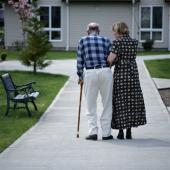
THURSDAY, Dec. 31 (HealthDay News) — “Frail” and “elderly” don’t always have to go together, say experts who have begun to shine a brighter light on the condition of frailty in older adults.
Among people older than 65, up to 10 percent are frail — a percentage that rises with age, according to a leading researcher in the field, Dr. Linda P. Fried, dean and DeLamar professor of public health at Columbia University’s Mailman School of Public Health in New York City.
Most people know frailty when they see a fragile elder, Fried said.
“If you ask people if they have ever known anyone who is frail, everyone holds up their hand,” she said. “They perceive [the frail person] as thin, weak, slow and as fragile.”
But Fried and other experts have a more scholarly definition of frailty. They see it as a constellation of signs and symptoms involving many bodily systems, all slowing down or shutting down. Typically that means weight loss, loss of muscle strength, perhaps cognitive decline and problems in other bodily systems. A frail person might have inflammation, anemia, too much body fat and problems with fine motor skills, for instance.
“I would define frailty as the loss of reserves in multiple systems, including physical and mental health as well as social supports,” said Dr. Claire Heppenstall, a clinical research fellow with the University of Otago in New Zealand. She has received funding from the Health Research Council of New Zealand to study fragile elders.
To Dr. Sharon A. Brangman, president-elect of the American Geriatric Society, the cumulative effect of problems is what leads to the frailty.
“It doesn’t look like it is related to any one organ system or problem but a conglomeration of dysfunction in many different organ systems, which results in a person having much less physiological reserve to recover from stressors, whether internal or external,” said Brangman, a professor of medicine and chief of geriatrics at the State University of New York’s Upstate Medical University in Syracuse.
A frail person, for instance, won’t likely bounce back from a bout of influenza or an emotional setback, such as the death of a loved one, as easily as a stronger older person.
“This means that even a minor insult, such as an infection or illness of a caregiver, can tip the balance and cause a cascade of adverse events to the extent that the person is unable to function in their usual environment and may require hospital admission or residential care,” Heppenstall said.
In a study published in the October issue of the Journals of Gerontology Series A: Biological Sciences and Medical Sciences, Fried and her research team found that three or more bodily systems functioning at abnormal levels was a predictor of which people would be frail. They looked at such factors as anemia, inflammation and fine motor speed. By itself, fine motor speed also predicted frailty, the study found.
So is frailty inevitable? Eventually, if people live long enough, it’s likely they will become increasingly frail. But “it can be delayed,” Brangman and others said.
Much of it is rooted in unhealthy habits picked up in early and middle age — “especially a lack of physical exercise, smoking and poor nutrition,” said Heppenstall.
“To prevent it, we should emphasize regular physical activity in all adults at all ages, as well as a balanced diet,” she said.
Exercise on a regular basis will at least delay frailty, agreed Brangman. “What we are trying to do is avoid that period of time when people are dependent and debilitated and have a lot of disability and need to be institutionalized.”
More information
The U.S. Centers for Disease Control and Prevention has more about healthy aging.

